Ghoom Monastery, also known as the Samten Choeling or Yiga Choeling Monastery, is a Buddhist shrine located in Ghoom, Darjeeling. It is a part of the Yellow Hat sect of Tibetan Buddhism known as Gelugpa and was established in 1850 by Lama Sherpa Gyaltsho. It is sheltered by 50 monks and in the hall a 15-foot-high statue of Maitreya Buddha which is made with clay brought from Tibet. Its serene atmosphere, vibrant murals, and rich history make it a perfect destination for pilgrims and discoverers.
Ghoom Monastery (Samten Choeling) Location
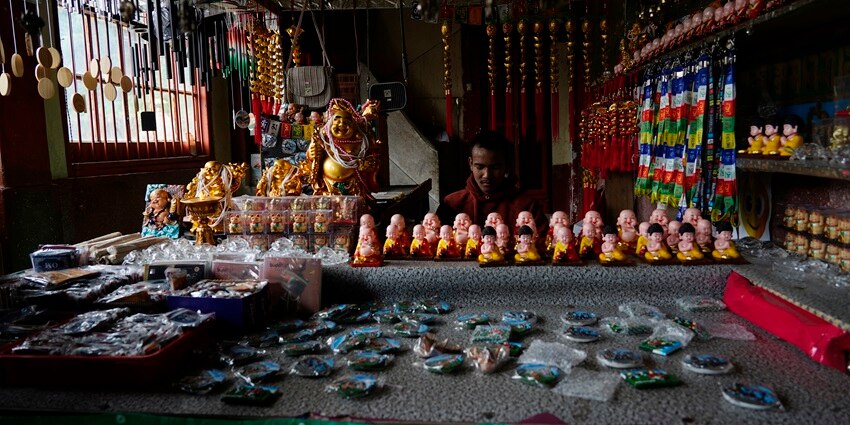
Photo: Amitabha Gupta / Wikimedia Commons
The holy Ghoom Monastery is located on Hill Cart Road and about 7 kilometres away from the town of Darjeeling. It takes less than 20 minutes to reach the monastery, starting in the city of Darjeeling and going to Siliguri on Hill Cart Road. However, it lies on the way to Batasia and Tiger Hill and can be visited as a 3-point tour. The monastery’s main attraction is the 26-foot statue of Lord Buddha, built recently in honour of the renowned scholar Lama Anagarika Govinda.
Suggested Read: Hill Stations Near Darjeeling
How To Reach Ghoom Monastery
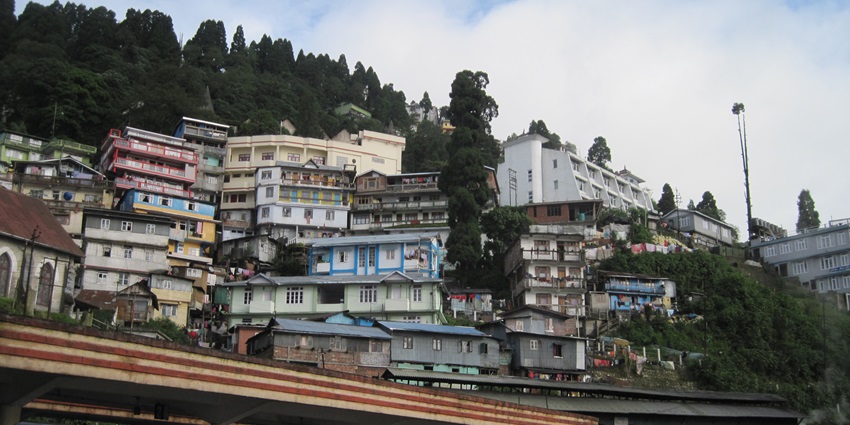
Photo: Aranya449 / Wikimedia Commons
The Samten Choeling can be reached via roadways, airways, and railways.
By Road: Samten Choeling is located at a distance of 7 kilometres from the town of Darjeeling. Tourists can reach via taxi, car, or bus.
By Rail: Samten Choeling is nestled at a distance of 1 kilometre from Ghum railway station. Worshippers can reach via taxi, car, or bus.
By Air: Samten Choeling is situated at a distance of 64.2 kilometres from Bagdogra International Airport. Visitors can reach via taxi, car, or bus.
Places To Visit In And Around Ghoom Monastery
Ghoom Monastery is a picturesque and religious place to visit. Apart from this, pilgrims can also explore other places in and around the monastery. Here is the list of main attractions:
1. Tiger Hill
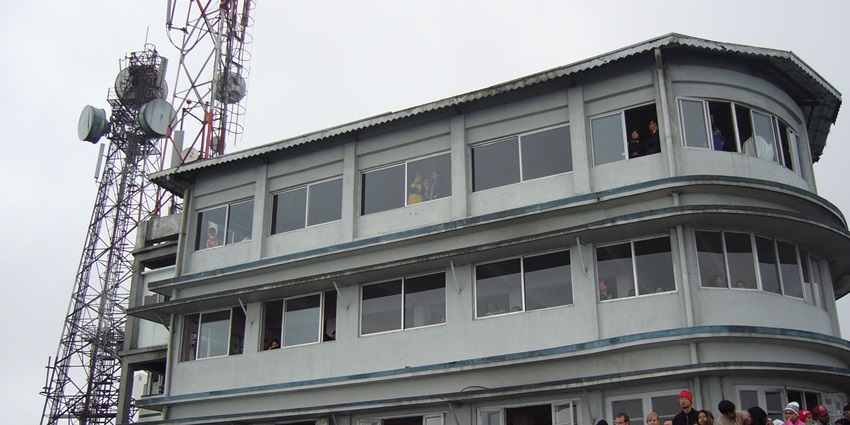
Photo: Shahnoor Habib Munmun / Wikimedia Commons
Tiger Hill is situated at an elevation of 7,407 feet above sea level, and it offers stunning views of the sunrise and sunset over the third-highest peak, Kanchenjunga. It is nestled at a distance of 11 kilometres from Darjeeling town, and it also offers adventurous activities to visitors, like trekking and hiking trails. The serene surroundings and majestic hills make it a perfect spot for photographers and discoverers.
Entry Fees: Rs. 20 (Ground Level), Rs. 30 (First Floor), Rs. 40 (Top Floor)
Timings: 3:30 AM (Summertime), 4:15 AM (Wintertime)
Suggested Read: Adventure Sports In Darjeeling
2. Padmaja Naidu Zoological Park
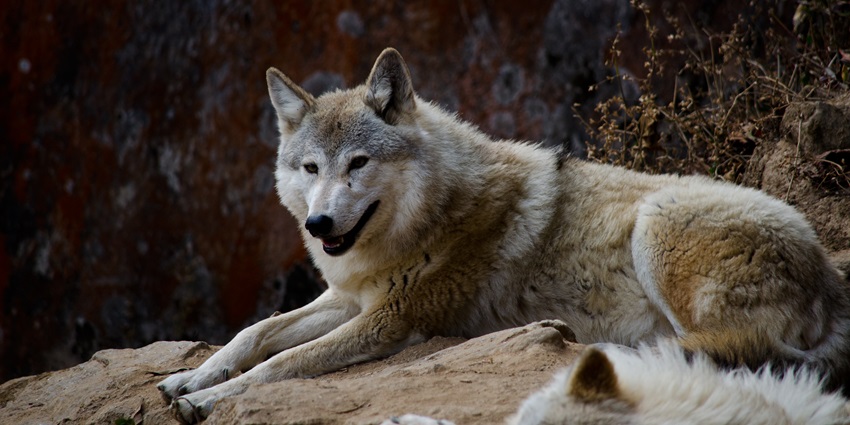
Photo: Abhishek.ghosh1984 / Wikimedia Commons
Padmaja Naidu Zoological Park, also known as the Darjeeling Zoo, is named after Padmaja Naidu, the daughter of Sarojini Naidu. It was established on 14 August 1958, spanning an area of 67 acres and home to over 200 species, including Snow Leopard, Red Panda, and Tibetan Wolf. Its main aim was to study and preserve Himalayan fauna, and it includes an off-display breeding centre for Snow Leopards and Red Pandas. The elevation of the zoo is around 7,000 feet, and it is considered the largest high-altitude zoo in India.
Entry Fees: Rs. 180
Timings: 8:30 AM – 4:00 PM
3. Darjeeling Himalayan Railway (DHR)

Photo: Syed Sajidul Islam / Wikimedia Commons
The Darjeeling Himalayan Railway (DHR) is often referred to as the “Toy Train” due to its narrow gauge and vintage charm. It was declared a UNESCO World Heritage Site in 1999, connecting Darjeeling to New Jalpaiguri. The routes of the train pass through the beautiful views of the Himalayas, hills, valleys, and tea gardens. It’s a lovely part of Darjeeling’s history and identity, and a ride on the DHR is a must-do thing for any traveller to the area.
Entry Fees: Rs.1500 (Steam Engine), Rs. 1000 (Diesel Special & Diesel)
Timings: Runs at their Scheduled Time
Suggested Read: Trekking In Darjeeling
4. Batasia Loop
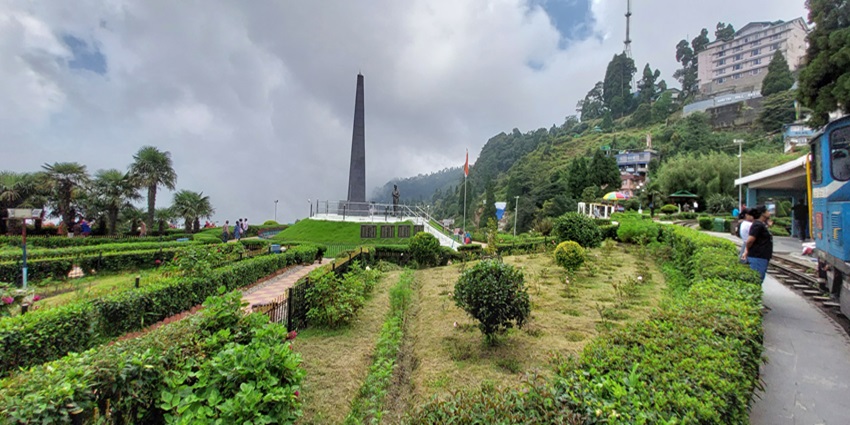
Photo: Pinakpani / Wikimedia Commons
The Batasia Loop is a panoramic railway loop located between Ghoom and Darjeeling cities. Batasia Loop attracts visitors for spectacular views of the Kanchenjunga and other snow-capped mountains. Nestled at an elevation of 1,000 feet above sea level offering a remarkable engineering marvel of DHR. The War Memorial stands at the centre of the loop which the District Sainik Board constructed. The War Memorial was consecrated on 22nd March 1995 in memory of brave Gorkha Soldiers who sacrificed their life to protect the sovereignty of the nation.
Entry Fees: Rs. 20 per person
Timings: 6:00 AM – 5:00 PM
5. Rock Garden
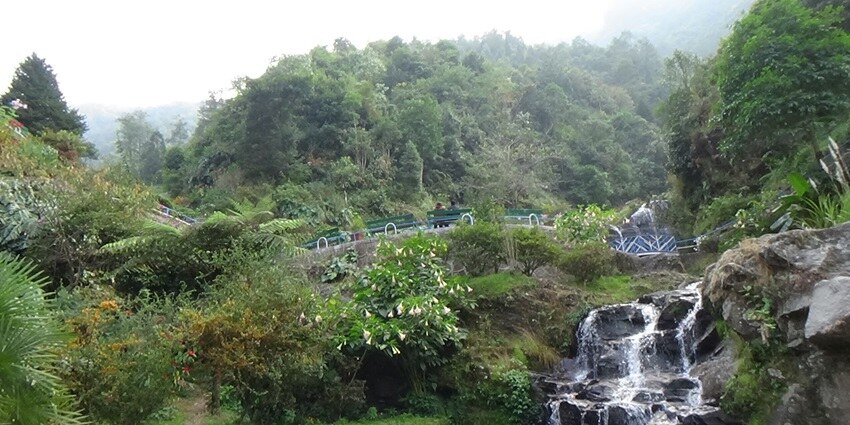
Photo: Csheik / Wikimedia Commons
The Rock Garden, also known as the Barbotey Rock Garden, is a serene tourist spot featuring cascading waterfalls, calm streams, colourful flower gardens, rugged rocky cliffs, and twisting walking trails. The Garden was constructed by Gorkha Hill Council Tourism Department and was inaugurated by Subhash Ghising, the GNLF Supremo. The garden is perfect for scenic spots, picnics, relaxation, and photography, making it an ideal destination for nature lovers and tourists.
Entry Fees: Rs. 10 per person
Timings: 10:00 AM – 4:00 PM
Suggested Read: Places To Visit In Darjeeling For Couples
Where To Stay
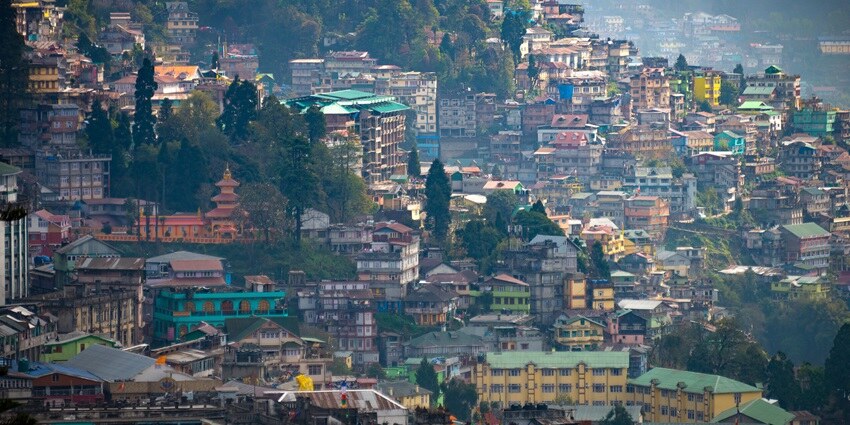
Photo: Anonymous / Wikimedia Commons
Darjeeling offers a variety of staycations that suit every visitor’s taste, from luxurious to budget-friendly stays. Near the Ghoom Monastery (Samten Choeling), some of the best accommodations include Norbu Thungkar Homestay, Sterling Darjeeling, Pahari Soul, Rani Kothi Heritage Residency, Zingo’s Home Stay, Swarna Kamal Homestay.
Where To Eat
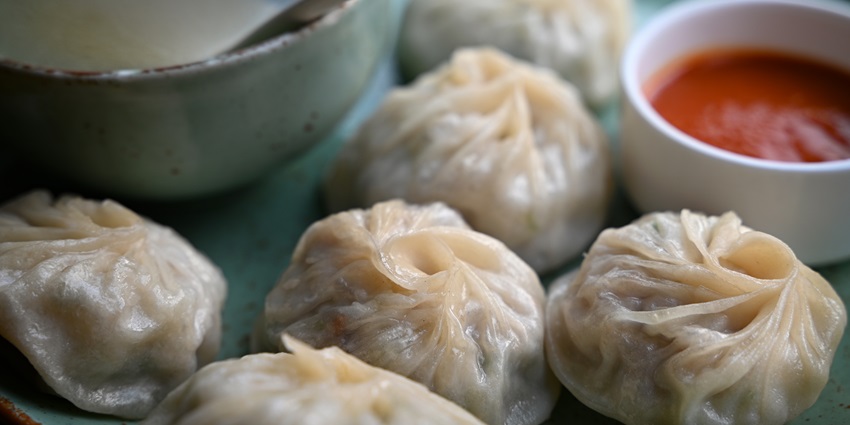
Photo: Sarkar Sayantan / Wikimedia Commons / Image For Representation Only
Darjeeling serves mouth-watering Tibetan dishes, and it says that a trip to Darjeeling is incomplete if you have not taken a sip of the world-famous Darjeeling tea. Darjeeling is also known for its cuisine, which includes Thukpa, Traditional Nepali Thali, Naga Cuisine, Churpee, and Momos. Delicaci Restaurant, Grains Pure Veg by Udaan Himalayan, Sonam’s Kitchen, Dekevas Restaurant, Coco Rio Cafe & Tea Bar, and Nathmull Tea are some of the top choices.
Suggested Read: Best Food In Darjeeling
Best Time To Visit Ghoom Monastery
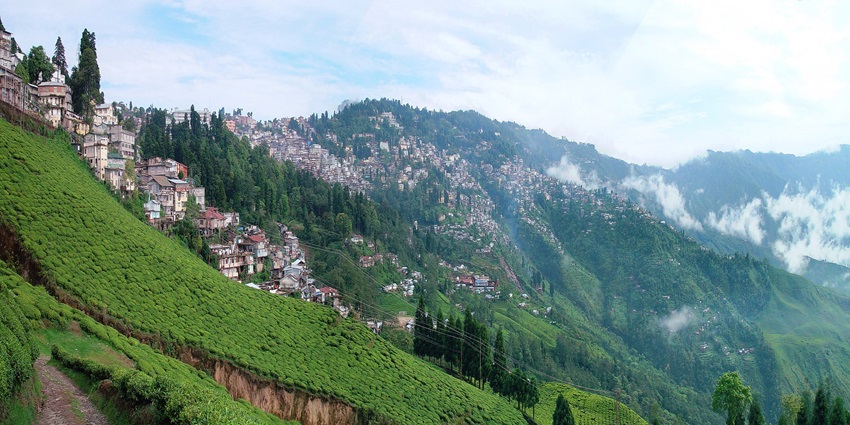
Photo: Darkone, MichaelJanich, Hph / Wikimedia Commons
The best season or time to visit Ghoom Monastery is from April to June. The weather is pleasant during this time and offers stunning views of the Himalayas and surrounding valleys. It is also considered the best season to watch regional carnivals and have time to relax in monasteries.
Other Factors To Consider
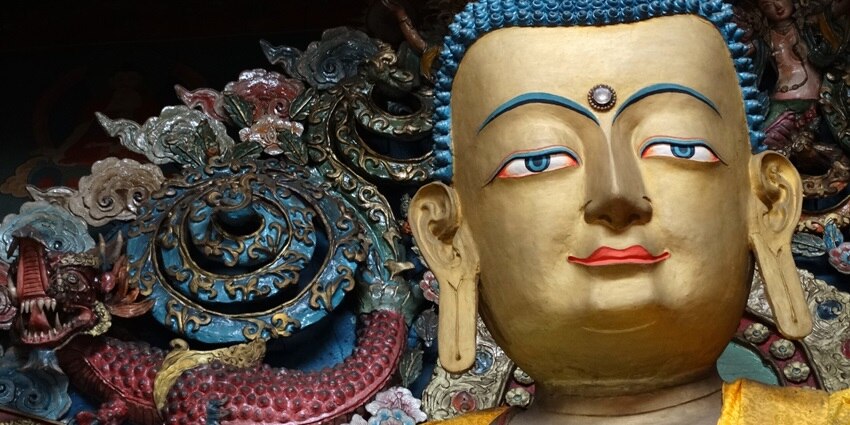
Photo: Adam Jones / Wikimedia Commons
Here are some factors to be considered before making a trip to Ghoom Monastery.
Average Cost Of The Trip: Visiting the beautiful Ghoom Monastery is economically viable. There is no entrance fee to the monastery. However, if visitors wish to explore more areas, then the price may vary.
Tips For The Travellers:
- Check the weather before visiting the monastery, as the place may be cold even in summer due to its high elevation.
- Respect the customs and traditions of the monastery, and dress accordingly.
- Remove the shoes and maintain silence where required.
- If needed, hire a guide who helps you to delve into the architectural style, customs, and traditions.
- Pack woollen clothes.
- Be polite to monks and locals.
Suggested Read: Shopping In Darjeeling
Ghoom Monastery (Samten Choeling), located at an elevation of 8000 feet, is a lovely symbol of calm and devotion that narrates several ancient and fascinating stories. As soon as the sun sets behind its grey walls, the beautiful Ghoom Monastery remains in the heart of tourists – the place where the soul seeks peace. So, plan your visit to the Ghoom Monastery with TripXL.


 WhatsApp
WhatsApp
 Twitter
Twitter









